What Were The American Waltham Nail Tin Boxes Used For
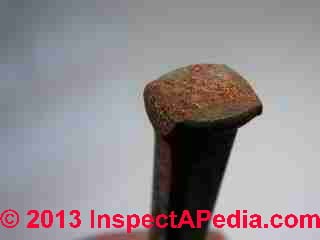 History & Photos of Nails
History & Photos of Nails
Age of Antique Nails & Cut Nails Indicates Edifice Historic period
- Mail a QUESTION or Annotate about determining building historic period past examining its hardware
InspectAPedia tolerates no conflicts of interest. We have no human relationship with advertisers, products, or services discussed at this website.
Antiquarian & modern Nails, including forest treenails, paw-wrought nails, cut nails, wire nails, compared.
Here nosotros depict antique and modern cut nails focusing on tree nails, wrought nails, and cut nails used in forest frame construction or interior finishing or carpentry work.
Nosotros include useful dates for the manufacture of different nail types along with supporting enquiry for various countries from Australia and the U.K. to the U.S. to New Zealand.
The history, number and types of nails is both interesting and enormous, even if we confine our word to only those used in the construction of buildings. Nosotros go on to add examples and photographs here and welcome readers to CONTACT US with contributions or suggestions.
This commodity serial describes and illustrates antique & modern hardware: door knobs, latches, hinges, window latches, hardware, nails & screws tin help determine a edifice's age by noting how those parts were fabricated: by hand, by automobile, by subsequently generations of machine.
Nosotros also provide an Commodity INDEX for this topic, or you tin try the page pinnacle or bottom SEARCH BOX as a quick way to discover information you need.
History of Nails & Edifice Hardware - Nail Photographs & Nails every bit Indicators of Edifice Age
 As a carpenter'southward nails are divided into wrought nails and cut nails; so mankind may be similarly divided. Little Flask was ane of the wrought ones; made to assure tight and final long. - Herman Melville, Moby Dick.
As a carpenter'southward nails are divided into wrought nails and cut nails; so mankind may be similarly divided. Little Flask was ane of the wrought ones; made to assure tight and final long. - Herman Melville, Moby Dick.
An exam of nails and fasteners and other building hardware is a complimentary effort useful in determining the age of a edifice and its components.
[Click to enlarge any prototype]
A close observation of the blazon of fasteners used in a building is one of the most pop means of estimating its historic period.
The iii types of nails establish in North American construction include hand wrought nails, automobile cutting nails, modern round "wire" nails.
Nelson (NPS) and other nail chronologists point out, however that a wealth other details tin can describe the date of production and use of each of those three general nail types. In turn, smash details can plant the time of original structure of a building and the time of modifications to the structure.
In addition to nails, building cloth, wood saw cut marks, and other hardware details can further assist in determining building age.
The nail shown above in the photo and detailed farther beneath was hand-made in the Northeastern U.Southward. before 1800 but could be even so earlier.
To provide a chronology of the product and types of nails we first draw wooden nails or "tree nails" followed by a chronological listing of useful dates for iron nails.
Wooden nails - Tree Nails or Treenails, Postal service & Beam Construction
 at Historic period of a Building, HOW to Make up one's mind we note the following:
at Historic period of a Building, HOW to Make up one's mind we note the following:
Post and beam construction (1700 - est. in North America): (timber framing) uses horizontal and vertical timbers that are connected (joined) using mortise and tenon joints pinned with wood pegs (treenails).
Timber frame structure initially used mitt hewn beams, later manually or mechanically sawn beams cutting by a pit saw. Later timber frame beams were sawn in mills using round saws.
Timber framing using postal service and beam construction with mortise and tenon joint connections was used in Europe for at to the lowest degree 500 years earlier information technology was first employed in North America.
In our photograph you can see the round sawn-off peg that secured the tenon of the lower vertical postal service into the mortise that had been cut into the horizontal beam.
The posts and beams were cut to size, mortises and tenons were cutting, and the builders marked the corresponding joint components with numbers or letters - in my photo you tin can run into the
I I I I
and
_
_
_
_
stamped into both the vertical post and horizontal beam to assist in assembly.
Below you can see the Treenail joining two rafters at the ridge of this 1790 home nigh Poughkeepsie New York.
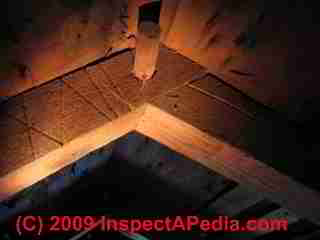
Past 1650 a typical timber frame building used multiple bents and girt beams, may have been more than than one story alpine, and included an exterior made of horsehair-reinforced cement stuccoed over hand-carve up lath.
More examples of uses of wooden pegs or treenails are at
- FRAMING MATERIALS, Age, Types
- FRAMING METHODS, Age, Types
- HEWN BEAMS & PLANKS
- SAW & AXE CUTS, TOOL MARKS, AGE
- SAW BLADE SIZE CALCULATED from SAW MARKS
Beneath is a machine-fabricated 3-inch cut blast fasten produced by Tremont Nail Co.
A Tacky Little History of Iron Nails
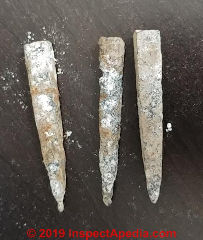 Nail Head & Nail Torso Details Help Set Smash Historic period
Nail Head & Nail Torso Details Help Set Smash Historic period
Photograph: sprites, small headless hand-wrought nails, discussed in more detail
at NAILS & HARDWARE, Historic period FAQs.
Adapting from diverse sources including Nelson's article cited below we requite a rough chronology of types and uses of nails, focusing on North America merely including other earlier nail product and use as well.
Earliest Nails - 300 B.C.
The Mansfield, Massachusetts Tremont Nail visitor's historical notes (cited below) indicate that nails have been made (by hand) dating back to 300 B.C.
Nails in the 1400s
The denomination of nail sizes based on the cost per 100 nails (east.g. 10 penny nails or 10d nails) dates from the 1400s.
In medieval England nails were made into a great variety of special shapes and sizes and sold by the hundred, east.m., 8d (pence) per 100 nails. From this practice developed the classification of blast sizes according to their price per hundred, a organization which seems to have been established by the fifteenth century. In 1471 for example, "fippenynayl" were only 4d per 100. In 1477 "xpenynayll" were but 8d per 100; and in 1494 "sixpenynayle" were 5d per 100.
Nails in the 1590s
The 1500s saw the first nail producing machines - First Boom Making Machines - 1590 Slitting Mills
The roots of producing nails by motorcar date from 1590.
Nails in the 1600s - 1900s: hand wrought nails
Paw wroughht nails were used for construction and later more for decoration.
The scarcity of nails in colonial Virginia was reflected in a statute enacted in 1645 to prohibit settlers from burning down old buildings for their nails. Some nails were fabricated in the colonies in the seventeenth and eighteenth centuries, but despite this local product very large quantities of nails were imported during the same menstruum.
Details are at NAILS, HAND WROUGHT
1766 - Atomic number 26 Nails Used as Barter
Although traditional Tahitian culture did not sanction extramarital sexual relations, within 48 hours of Wallis'south arrival, Tahitian husbands and fathers were encouraging their wives and daughters to swim out to the Dolphin and offer the sailors sex activity in exchange for fe nails.
Aware of the brisk trade in atomic number 26, later explorers such equally Captain James Cook brought supplies of nails and hoop iron with them to barter for freshwater, fish, pork, and vegetables.
Cook's visits [to Tahiti] in Apr 1769, Baronial 1773, and August 1777 only heightened the islanders' desire for iron and other western goods. . (Denver, 2013 Tahiti, p. 682-683).
1775-1783 Nails During the American Revolution
The colonists shifted to local production of nails and smash import from England was reduced or ceased altogether.
First Nail Making Machines in North America - 1790 "Cut Nails"
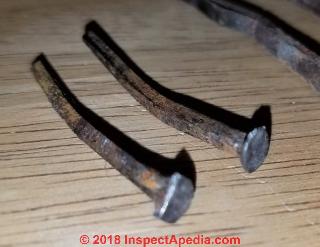 1772 - 1820: In Due north America early car cut nails
1772 - 1820: In Due north America early car cut nails
Dating from 1590 in England, as the earliest report of nail production, the earliest reported cut nails in America are reported to accept been cut, essentially by-paw, by Darrow in 1772 (Federal Writers Project 2013) with other authors crediting the Wilkinson brothers somewhat later, ca. 1783 (Bridegroom 1883).
Nelson notes the first generation of cut nail manufacturing involved cutting all nails from common sides with heads hammered on as a separate production step.
The get-go nail making machines in North America appeared during the late 1700's - earlier than i might have guessed.
The slitting manufacturing plant, introduced to England in 1590, simplified the production of nail rods, just the real first efforts to merchandise the nail-making process itself occurred between 1790 and 1820, initially in the United States and England, when various machines were invented to automate and speed upward the process of making nails from bars of wrought fe.
These nails were known as cutting nails or square nails because of their roughly rectangular cross department.
Cut nails were ane of the important factors in the increase in balloon framing offset in the 1830s and thus the decline of timber framing with wooden joints. (Kirby 1956)
Higher up and shown merely beneath are nails used to secure accordion board - a plaster base of operations found in a rural U.S. post-and-beam home in Wyoming County, New York.
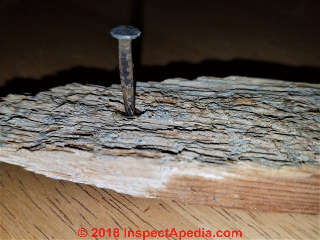
More about the piano accordion wood lath in this edifice and our estimate of the building age are
at Woods LATH, TYPES.
Beneath: our green arrow points to the feature border ridge that illustrates a machine made cut-nail.
The cherry-red arrow points to a split up in the cutting blast, characteristic of the effort to align the fibres of atomic number 26 running down the length of the nail - discussed in our description of nails made afterwards 1830 - below. .
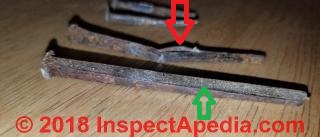
These photos of antique cutting-nails were provided by an InspectApedia.com reader June 2018.
As I mentioned about a different smash in photos on this page, the fact that the delaminating or split in this smash run lengthwise (parallel to the nail shank) suggest that the boom was of iron whose fibers ran lengthwise, making the nail ane probably fabricated afterwards the late 1830s.
For these nails, because information technology appears that the ii cut/stamping burrs appear on the aforementioned side of the blast suggest the nail may take been made after 1840.
Below: Jacob Perkins' 1795 Nail Production Machine Patent. Perkins was a polymath described as an inventor, mechanical engineer, and physicist [Wikipedia] who held 12 American patents and some other nineteen English patents. His machine for cutting and heading nails was issued when Perkins was only 24 years old. His nail factory was powered by water from the Powwow river in Amesbury Massachusetts.
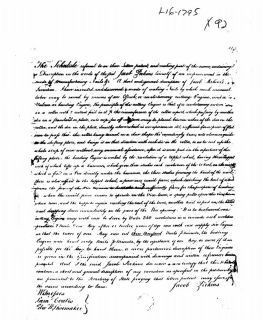 [Click to overstate any image]
[Click to overstate any image]
Though still used for historical renovations, and for heavy-duty applications, such as attaching boards to masonry walls, cutting nails are much less mutual today than wire nails. - source: https://en.wikipedia.org/wiki/Nail_(fastener) retrieved 2018/06/15
The cut-nail process was patented in America past Jacob Perkins in 1795 and in England past Joseph Dyer, who set machinery in Birmingham. The procedure was designed to cut nails from sheets of iron, while making sure that the fibres of the fe ran downwards the nails.
Too see Pitt (2003) cited below.
Jacob Perkins' NAILING MACHINE PATENT No X-92 [PDF] was granted Jan. xvi, 1795, to Jacob Perkins, Newburyport, MA, witnessed by Sam Coates and Edward W. Shoemaker. Regrettably all of the drawings are missing from the patent scan. Here nosotros reproduce the photographic copy of Perkins' nail machine patent; the photo itself was made from the original on 3 March 1911.
Note: the first U.S. patent was issued in 1790, and in 1795 the U.S. issued simply 12 patents.
Question: who made the kickoff cut nails in America?
Bob Dees said:
Co-ordinate to "The WPA Guide to Connecticut: The Constitution Land", Past the Federal Writers Project.
The first cut nails produced in America were produced by Edmund Darrow in 1722. It says:
"Early industry did not attain any importance until 1772 when a Bean Hill blacksmith, Edmund Darrow, produced from barrel hooping the first cut nails in America".
- books.google.com/books?id=E07pCAAAQBAJ&pg=PT324&lpg=PT324&dq=Edmund+Darrow+1772&source=bl&ots=D6v851C38P&sig=ACfU3U3CziUWfa8g5zLnoFOeE62bQF-oWg&hl=en&sa=Ten&ved=2ahUKEwiuz6yx4-bpAhWQT98KHYZEBIwQ6AEwAHoECAYQAQ#5=onepage&q&f=false
There is some other reference: "Reminiscences of Edible bean Colina, Norwich" page 297, written in 1897 by Burrell W. Hyde that states the same thing.
- play.google.com/books/reader?id=Wv8aAAAAYAAJ&hl=en&pg=GBS.PA297
Your website states that the offset cut nails were made in 1790 (18 years afterwards than 1772).
Tin you tell me who is correct? I'm doing a research projection and am wondering which reference is correct.
Thanks very much. - 2020/06/04
Moderator reply:
Bob
Thanks for the discussion, Bob. I think that for clarity nosotros should distinguish betwixt actual production of "cut nails" that included transmission cutting of nails out of existing sheet iron (similar a barrell hoop), and nail making machines that in plow could produce large volumes of nails.
My favorite source, often cited, for the history of nail making is Nelson, but the article above and also the references at the terminate of this page cite several sources.
Higher up, from Nelson, nosotros note that nail making machinery dates back to 1590 - in England.
The slitting factory, introduced to England in 1590, simplified the product of nail rods, merely the existent first efforts to trade the nail-making process itself occurred between 1790 and 1820, initially in the The states and England, when various machines were invented to automate and speed up the process of making nails from confined of wrought iron.
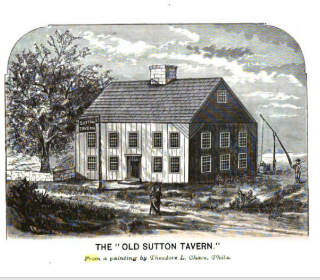 To go back to your original annotate, citing
To go back to your original annotate, citing
- Bridegroom, Westward. Charles, History of the Boondocks of Sutton, Massachusetts, from 1704 to 1876: Including Grafton Until 1735; Millbury Until 1813; and Parts of Northbridge, Upton and Auburn. boondocks, 1878.
we have on page 279 this past the author:
The author was discussing, in history of Sutton MA, the "One-time Sutton Tavern", (an engraving is shown in the book) and writes nigh hand wrought nails used in structure of the tavern:
"As will be seen by the engraving, that represents it equally it originally appeared, the siding consists of thick oak planks nailed perpendicularly to the frame, and at each of the upper corners the planing is placed diagonally, for the purpose of giving additional strenth in bracing the edifice.
The clapboards were not added until a afterwards menstruum. They were cloven by mitt and fastened by hand-fabricated nails, * cut nails existence then unknown.
* About the time of the close of the revolutionary war two brothers of the name Wilkinson, who had ironw orks in Cumberland, R.I., cut a lot of nails from some quondam butt hoops, "Spanish hoops," as they were called, and these are supposed to take been the get-go cut nails always made.
Then nosotros have
The start cut nails produced in America were produced by Edmund Darrow in 1772. (Federal Writers' Project 2013) cited by you lot
Extract: "Early industry did non attain whatsoever importance until 1772 when a Bean Hill blacksmith, Edmund Darrow, produced from barrel hooping the start cut nails in America".
And a similar but less explicit appointment crediting the Wilkinson brothers in Cumberland R.I., ca 1783 (every bit the American revolutionary war is dated as April xix, 1775 - September 3, 1783) - (Benedict 1878)
Benedict was writing a fleck nether 100 years after the end of the revolutionary war so was closer in time to the consequence of involvement, but on the other mitt the very recent (2013) Federal Writers' projection may benefit from more extensively-available resources.
In sum I'd like to duck the trouble of who fabricated the commencement cut nails by describing the history as
Dating from 1590 in England, as the earliest report of nail production, the earliest reported cut nails in America are reported to have been cutting, essentially by-hand, by Darrow in 1772 (Federal Writers Projection 2013) with other authors crediting the Wilkinson brothers somewhat later, ca. 1783 (Benedict 1883).
Likewise in
James Campbell, Nicholas Bill, Karey Draper, Patrick Fleming, Yiting Pan, Wendy Andrews, Proceedings of the First Conference of the Construction History Order (2015)
[This book collects together the papers delivered at the first annual conference of the Structure History Society, held in Queens' Higher, Cambridge in 2014. Papers cover a broad range of topics all on the common theme of the history of construction, from the aboriginal earth to the present day.]
We have a discussion of American cut nails and also of the British cut clasp nail, kickoff on p. 233

American cutting nails
With some justification, the Americans merits that auto production of cutting nails was an American invention. From a simple kickoff, the lever-operated guillotine motorcar patented by the prolific Jacob Perkins in 1795 was developed past various independent inventors into a series of efficient cut boom fabrication devices. [21]
By 1810 water powered nail machines had been adult, although American nail making predominantly relied on transmission machines.
Nails of a primitive sort could ever be cut manually by a blacksmith from heated butt hoop or other strip atomic number 26 and several instances of this resort to basics are recorded in the 1788 colony at Botany Bay. [22]
Perkins' afterward car took the process i stride further and cut tapering shanks from a heated iron ribbon. In society to maintain a taper to the proto shank, the ribbon either had to exist wiggled through a shallow horizontal arc or flipped over between each cut.
Perkins' machine was entirely manual, but recent research has shown that at "black rut" of effectually 500 degC, the shear force of a typical nail shank drops to roughly 300 kilograms. Using leverage. this is hands attainable. [23] The device significantly speeded uip the cut of basic nail shanks.
These uncomplicated headless brads have been found in Britain both of iron and steel, and were usually used in flooring or specialist work. (Fig. 3, blast i). In American they would exist re-heated and headed separately with either conventional facetted heads or bulbous oval heads would exist formed with a hand-held die. ...
Reader follow-upward
Bob Dees said:
Thanks very much. If I tin can find a more definitive, more than descriptive narrative of the 1772 Edmund Darrow cut nails of Norwich CT, I'll let yous know. - 2020/06/04
1805 - present: nails fabricated completely by car
- Nails made completely by auto, including the smash head, appeared equally sprigs and brads as early equally 1805, and keep in apply to the present. (Nelson US NPS cited below.)
- 1806 - Blanchard Tack Making Machine - 1806
Thomas Blanchard was built-in on June 24th, 1788, in Sutton, Massachusetts, virtually Worcester. His outset invention was a tack making machine which he invented at age 18 and perfected over the adjacent half-dozen years.
This made production of tacks, which Thomas and his brother had been previously engaged in making, easier and more efficient at a rate of five-hundred per minute.
- U.S. NPS cited beneath. - 1810 - 1820: cut nails were made cutting from opposing sides and used heads hammered on equally a carve up product stride.
Cutting from opposing sides means that the shear cut that produced the nail was made from opposing sides of an atomic number 26 or steel blank slab.
Take a wait at the shear marks on your nail to see if they are both on one side or if they appear on opposing sides. See the "burrs" illustrated as adapted from Nelson in the citations at the end of this commodity.

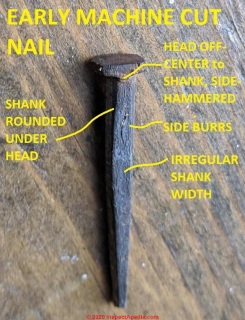
[Click to enlarge whatsoever image]
- 1815 - late 1830s: crude auto made or auto cut nails, first auto made heads.
Illustration above: properties of early automobile-headed cut nails, - US NPS, Lee Nelson (cited below).
Photo above: early machine cut nail photo, courtesy of reader J - 2020/05/23
[Click to enlarge any image]
Question: is this an early machine-cut nail?
 J said:
J said:
I was recently repairing an old dresser I had gotten from a thrift store and institute some very quondam looking square nails, which led me here.
They appear to exist early on machine cut nails based on your photos. Is my cess right?
Moderator reply:
The ascertainment that your nail is irregularly tapered from below the head, getting wider, so narrowing again, suggests that information technology's an early car-cut smash, perhaps roughly between 1815 - 1839 according to Nelson in our references.
In the article higher up and also over again at NAILS HAND-WROUGHT & REPRODUCTIONS we note from Nelson'southward research that ...
If your cutting nail is irregular in shank width and has the "A" type side burrs it's probable to have been made earlier the late 1830s.
- 1820s - 1830s: rough machine made heads
Earlier the 1830s the atomic number 26 fibres in machine cut nails ran across the nail shank, causing the nail to suspension off if the user tried to clinch it's protruding cease.
For this reason, before the 1830s and where nail clinching was needed carpenters continued to use hand-wrought nails. (Nelson).
Cut nails made earlier the late 1830s will typically have:
- an irregular and possibly off-heart caput
- a head that may have been hammered to permit counter-sinking
- a shank of irregular width
- burrs that possibly on opposing sides of the blast shank depending on the cut machine
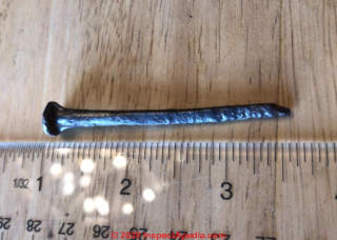
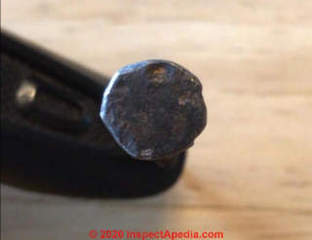
Above: photos of Dan Nelson's early auto-made nail discussed but below.
Question: New England Nail estimated age 1830 +
2020/04/20 Dan Nelson said:
Hi,
I found this blast while metal detecting an old hayfield in northern Vermont.
The caput is round.
The start quarter inch or so of the shank from the head is round-oval.
From in that location to the point, the nail is very square and tapered.
I do non sympathise why there are fins on the shank directly below the head. I have found coins I the surface area as far back as 1787.
I would similar to be able to know the rough historic period of this boom. Thanks.
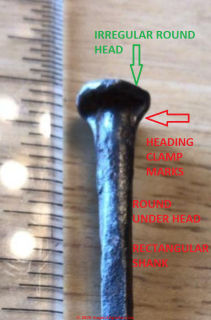
Answer: details of early automobile made nails, rounded head & upper shank, rectangular lower shank
Dan,
Thanks for the helpful photos of your antiquarian boom. My judge of the historic period of your nail is 1830 or a bit older, with an "earliest" date of 1815.
On that page I cite Lee Nelson:
Nelson, Lee, Nail Chronology Every bit An Aid to Dating Sometime Buildings, Technical Leaflet 48. Nashville: American Association for State and Local History, 1968
and
Nelson, Lee H., NAIL CHRONOLOGY every bit an AID to DATING OLD BUILDINGS [PDF], U.S. National Park Service, Technical Leaflet No. 48. retrieved 2019/01/08, original source: npshistory.com/publications/nail-chronology.pdf
Looking carefully at the irregular-round smash head in your photo and the compression marks but below the blast head, the earliest we could date this nail might be 1815-1830,
or in my Opinion, probably a flake later, equally tardily as 1850. I think some early on blast making machinery often had a longer life than ascribed by Nelson. In some communities, quondam blast making motorcar may have, for a time, continued in product alongside afterward, more-sophisticated machines producing more-rounded and more-uniform nails.
Fabricated in the U.Due south. in the East, this is an early machine-made nail characterized, per Nelson, by its irregular-round caput and the combination of a rounded shank and compression marks from the nail heading clamp, transitioning to a rectangular shank for the residuum of the blast.
Your nail is large enough that it would non have been later modified (by hammering the head) to catechumen to a "finishing nail" that could be countersunk. Instead this three one/2" long nail would have been used as a structural connector.
In the U.South. the earliest manufactured nails (1790-1830) were operated past hand, later past water mills and yet subsequently past steam engines.
Because the rounded upper boom shank looks regular I suspect this is one of the later members of "Early Machine Headed Cutting Nails" nails, 1830 - 1850 described by your namesake.
Nelson points out that these early on automobile-made nails were more readily available than machine-made finishing nails, and that they were often irregular in both length and diameter or width - something yous cannot see when nosotros take merely 1 nail only that we might run into if we were examining multiple nails from an old New England edifice.
A shut look at the rectangular sides of the smash shank may show the remains of a long burr along the shank feature of early on cut nails. The burr remains on the side of the nail that was cut from a flat iron plate that was opposite the descending shear bract.
Tapering was produced by "wiggling" the atomic number 26 plate side to side equally the shear descended to cut private nails.
The irregular rounded head was made in a subsequent pace past kickoff clamping the nail shank so that the head could exist compressed - hence the rounded shank with pinch marks on the upper part of the nail just under the smash head.
1830 - Present: Modern Machine Made Nails
Annotation direction of iron fibres in nails and spikes
Photos below: large iron fasten found near Elmira, Ontario past Vern G shows laminar splitting along the length of the smash shank, giving an earliest date of 1830.
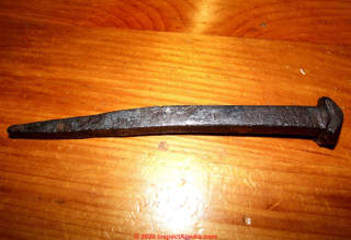
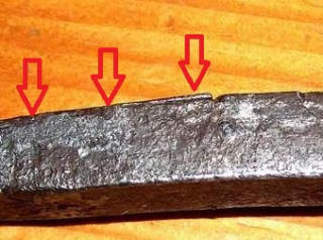
Below: Tony's RR spike found on the Oregon Coast is an instance of how rust patterns can advise the management of fe fibers in a blast. [Click to enlarge any paradigm]
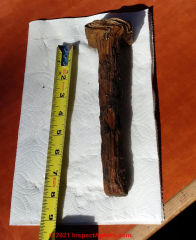
Question: Canadian fasten: estimated historic period 1830 + shows laminar splits forth spike or smash shank
I take a spike that was taken out of the old farm house where I was built-in and raised . It was located 3.v miles east of Elmira Ontario Canada. A engagement was inscribed into the basement wall during construction nevertheless information technology was non done clearly.
We cannot determine if it is 1803 or 1863. I was hoping that yous may exist able to tell when this house was built past this spike.
At that place is a very slight split in the metal most one half of the way down the shank.
The head is quite unique as information technology appears to have been crimped downward in the corners to create a square on the tiptop in a different direction than the base of operations of the head. Any assist you could provide would exist appreciated. - (Mar 24, 2020) Vern M
Reply:
Thanks for the interesting boom photo, Vern. I'd like to meet a sharp closeup of the split in the smash.
As I mentioned virtually a different nail in photos on this page, the fact that the delaminating or carve up in this smash run lengthwise (parallel to the smash shank) suggest that the nail was of iron whose fibers ran lengthwise, making the nail one probably made later the tardily 1830s.
For these nails, considering it appears that the 2 cutting/stamping burrs appear on the same side of the smash advise the boom may take been fabricated afterwards 1840.
- 1830 - present: Modern automobile-cut nails that resemble nails still used today appeared in North America in the late 1830s.
Cutting nails were cut from opposing sides, improved or "perfected" car made nail heads.The presence of machine cut nails is a reasonable indicator that a building was constructed (or site occupied) in the 1830's or later. (Adams 2002).
Cut nails made after the late 1830s will typically accept:
- nail heads that are uniform and are convex on both sides
- uniformly-tapered shank width or sides
- cutting car burrs both on the same side of the nail
- were made of iron whose fibres ran lengthwise [come across Ashley'south blast atomic number 26 cobweb and Tony's railroad fasten rusty iron fibres in photos to a higher place], so these nails tin exist clinched without breaking off
- volition differ little from modern (2019) cutting nails
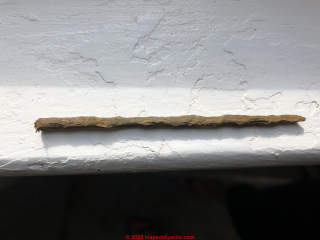
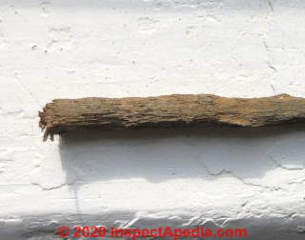
Photos above: fragments of an iron nail appearing to bear witness iron fibers running lengthwise forth the shaft of the blast, courtesy of reader Ashley who wrote:
Tin you requite me your stance on these ii pieces I plant. We live near 700 ft from one of the first North American settlements circa 1630'due south. - (Apr 12, 2020) Ashley
The laminar splits near the blast head suggest old iron, likely to have been forged as early as 1830. - Mod
1832 - Present: Cutting Spikes, Railroad Spikes
In our images above you'll detect that the caput of these big railaroad spikes sport an offset caput. The larger lip of the get-go head on these large spikes, also called crampons, was used to secure the bottom edge of the runway to the steel plate upon which the rail rests.
As the railroad spike is driven through the plate and onwards into the railroad necktie or (sleeper), the combination of spike, tie-plate, and sleeper hold the rail in place in the stone-covered bed (ballast) of the railway.
Details are
at RAILROAD SPIKES
1848 - Present: Original as well equally Reproduction of Antique Nails
- 1848 - Present - Original-employ and currently reproduction of antiquarian nails, Tremont Nail Company
Details are at TREMONT Antiquarian NAIL REPRODUCTIONS
- 1850 - present: Modern wire-nails (nails that are round in cross-department) appeared in Northward America in the 1850s and continue to the nowadays.
Round or "wire nails" are produced past cutting a circular fatigued wire into lengths to which a betoken and head are added by the machine.
Details and more images are at WIRE NAILS
1870 - Present Modern Round or Wire Nails
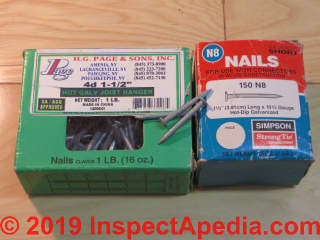
Above, an example of mod round or wire nails, galvanized fasteners. These 4d 1 1/2" galvanized nails are designed for utilise with steel joist hangers.
Wire nails were produced in Northward America from virtually 1850 to the present. Early wire nails were made showtime in smaller sizes.
If nosotros exclude nails coated with a galvanized or other fabric, most modernistic wire-type nails volition show parallel indentations across the top of the smash below the caput, indicating the grip on the nail shank as the nail's head was formed.
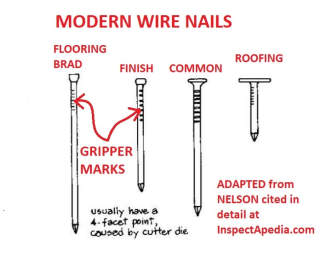
- 1870 - Competition from Wire Nails (round) - 1870
The Birmingham industry expanded in the following decades, and reached its greatest extent in the 1860s, after which it declined due to competition from wire nails, just connected until the outbreak of Globe War I. (Sjögren 2013) - source: https://en.wikipedia.org/wiki/Nail_(fastener) retrieved 2018/06/15
Ezekiel Reed from Bridgewater Massachusetts developed the beginning machine that could cut a nail including its head in one operation.
In the U.South. the Parker Mills smash company was congenital in 1819 on the original site of the Parker Mills cotton mill that had been burned past the British during the State of war of 1812.
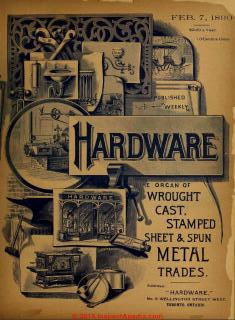
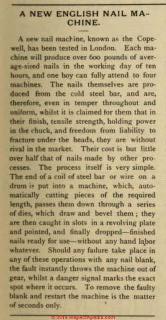
Above: Hardware Merchandising magazine article discussing a new English nail making automobile, 7 Feb 1890.
[Click to enlarge any paradigm]
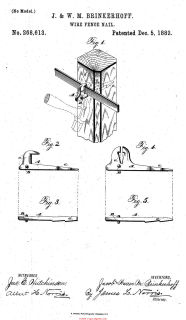
- 1880's - special purpose nails, eg. wire nails and spinous-wire fencing nails using hooked smash heads and sometimes, shank details that resisted inadvertnet withdrawal from wood fenceposts just making future removal possible when wire fencing needed to be repaired or adjusted - shown above the Brinkerhoff wire argue blast patented Dec. 5 1882. The boom head featured details that eased withdrawal of the nail using a hammer.
Brinkerhoff, Jacob & Warren M. Brinkerhoff, WIRE-FENCE-Boom [PDF] U.S. Patent No. 268,813, Dec 5, 1882
George, Washington. "Boom-staple for barbed wire." U.S. Patent i,389,540, issued August xxx, 1921.
- 1890 - Loftier Volume Production of Cut Nails Continues - 1890
Past 1890 nail making machinery had avant-garde to produce cut nails at loftier volume and depression cost and at improved reliability. (Hardware Merchandising 7 Feb 1890)
The Parker Mills boom company became the Tremont Smash visitor that continues to produce traditional machine-made "cut nails" today. [1]
The development of automobile fabricated nails that could be produced in high volume was critical to this change in construction methods. But fifty-fifty in the 1930's and forty's nails were a meaningful cost of construction.
1950 - Present: Modern Nail Guns & Ability Nailers
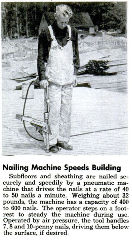
Illustration to a higher place: Popular Mechanics, March 1950, p. 96 describing the new "smash gun".
- 1950 nail guns in use in forest frame construction. Modern round or wire nails dominate nail apply in conventional framing and structure, really replaced by nails formed to work in power nailers or "nail guns" for much wood-frame construction.
The nail gun was designed by Morris Pynoos, a civil engineer past grooming, for his work on Howard Hughes' Hughes H-4 Hercules (known as the Spruce Goose). The wooden fuselage was nailed together and glued, and then the nails were removed.The offset nail gun used air pressure and was introduced to the marketplace in 1950 to speed the construction of housing floor sheathing and sub-floors.
With the original nail gun, the operator used it while standing and could nail forty-60 nails a minute. Information technology had a capacity of 400-600 nails.
- Wikipedia, Nail Gun, retrieved 2019/01/09, original source: https://en.wikipedia.org/wiki/Nail_gun
Analogy below: Paslode nail gun nails sold in strips are still "wire nails" but are no round in cross-department.
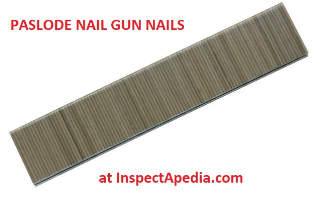
- 2019: mod smash guns. Modernistic nail guns are sold in models that operate by compressed air, electricity, or gas cartridges. Manufacturers of nail guns in 2019 include at least the following nailer brands: A.D.I. Atachi, aka ADACHI, AEG, AirPress, Bostitch, DeWalt, Heico,m Hitachi-Koki, Makita, Milwaukee, Paslode, Rigid, Senco, Spit-Impex (physical nailers), Sumake,
Paslode, a division of Illinois Tool Works, is one of a number of manufacturers of modern nail guns, sold in both cordless and pneumatic (air powered) models. Paslode was founded by J.W. Leslie in the U.S. in 1935.
Hand Wrought Nail Details
Details of Paw-wrought nails used in North America in the 17th, 18th, and 19th century in American building construction as well every bit modernistic manus wrought nail reproductions are now found
at NAILS HAND-WROUGHT & REPRODUCTIONS
Research on History of Mitt Wrought Nails, Cutting Nails & Wire Nails
This department has moved to NAILS & HARDWARE, Age Research
where we provide photos, text excerpts & research citations for the history of production and utilise of nails for various countries including Australia, India, the U.K., Scotland, Wales, The United states of america, and New Zealand.
Reader Q&A - also run across the FAQs series linked below
@Cowin,
Thanks for the added detail.
Those regular nail shanks, absence of tool marks, and the regular burrs along the shank edges also advise modern production. Tin you say whether those are bronze, or now that I look again, fe, or what is the metallic?
You will find our nigh-complete communication on guessing historic period at Smash AGE Conclusion Central https://inspectapedia.com/interiors/Make up one's mind-age-of-one-time-nails.php
And you might try Google image search or a google search on any nail codes or letters you are seeing in the nail head.
It's worth a google search - exist certain to include the country and city closest to where institute when doing a search.
Lamentable non sure what you hateful. I don't think they are bronze. I was wondering if they can be identified by the headstamp. Maybe english language 1800s?
They are simply around 12cm in length
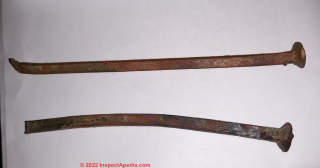
@Cowin,
Those look like twentieth-century spikes that might accept been used on a send or a dock
Hi. I establish these 2 nails in eastern nsw site. Tin you please help me with identifying them? I has what looks like a diamond shape head postage and the other looks like either an 50 or the number vii. Please see attached picture

@Andrew Cowles,
Thanks. Overnice photo.
The head suggests a fairly modernistic machine made decorative smash.
Hullo Guys,
I found this interesting Iron smash in my garden. It's square and seems hand forged, but has a nice domed copper head.
We're in the UK. Any idea what menses it would exist from?
Many thanks,
Andy
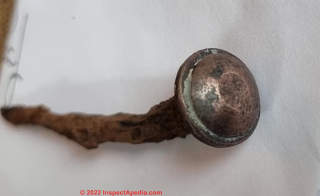
@inspectapedia.com.moderator, I found this spike metal detecting in MO. Anybody can help me date information technology. Four sided fasten
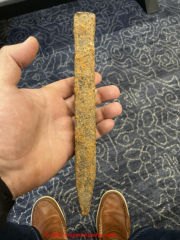
@Simon,
Yous tin see our most-complete advice on guessing historic period at
NAIL AGE DETERMINATION Central
https://inspectapedia.com/interiors/Determine-age-of-old-nails.php
The blue origin nonetheless is some other question and one I don't accept an reply for.
Drift forest with single nail. Trying to found age and maybe blue origin
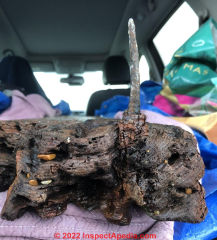
Plant in very erstwhile stone wall ? Any ideas? Located in Massachusetts

@Steve Campbell-Wright,
The round upper shank of your nail makes information technology a modern fastener.
Be certain to come across the boom ID and age tips given at
Nail AGE Conclusion Central - use this key to approximate at the age of your nail or spike
I am hoping to identify this blast. It is 3 inches long with a head dia of 9/16". The upper office of the shank is round, and the lower part is forged to a rectangle with a chisel signal. At that place is a 'West' forged into the countersunk head.
What is its purpose, and how old is it please?
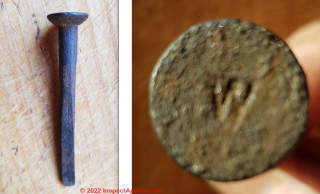
@Jason M Gould,
I'yard non sure what y'all hateful past molded nails, but if y'all mean round wire nails, their history is included in the page above.
@danjoefriedman, thank you!
When did the moulded (molded?) nails become popular then?
@Jason Thousand Gould,
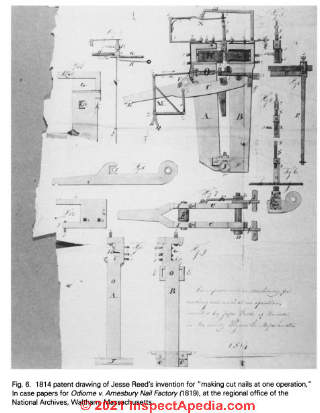 Information technology certainly has merit. Nails were cutting from forged blanks, even past hand-operated machines at least from the early 1800s and possibly as early as 1790. (How, 2018 & How, 2009 ) (Phillips, 1993).
Information technology certainly has merit. Nails were cutting from forged blanks, even past hand-operated machines at least from the early 1800s and possibly as early as 1790. (How, 2018 & How, 2009 ) (Phillips, 1993).
Cut nails were valuable, and in improver to being made past pocket-sized mitt operated machines would have been imported from England, from France, and perhaps besides made farther West in the U.S. or shipped to that declension.
@Jason Grand Gould,
Continuing, Phillips notes that
By 1788, Adam Rogers, of Marshfield, had developed a automobile that "cut nails from hoops or plates," and past 1792 his nephew, Samuel Rogers, was cutting nails "past paw in a minor machine invented by him.
When cutting from nail plate, the nails produced past the paw-operated machines would probably have had characteristics similar to those of nails manufactured a few years later, but with less refinement.
The earliest cut nails would accept had shanks with two tapering and ii parallel sides and burrs on diagonally contrary edges (having been cut from the same side of the nail plate), like their later cousins.
However, considering of the crude, somewhat uncalibrated method of cutting, the shanks in cross-section would probably have appeared as skewed rectangles or parallelograms, rather than truthful rectangles (Fig. 2).
The nails would have had rounded ends (from the edge of the boom plate) and were probably initially manus-headed, sometimes with faceted rose or "T" heads constitute on wrought nails, other times the upper end merely aptitude over to produce a brad.
Eventually, crude heading machines may take been used.
Below, courtesy of Phillips (1993) is an illustration of the 1814 Reed Cutting Nail Machine patent, found in the patent infringement lawsuit papers in Oiome v. Amesbury Nail Factory (1819) at the regional office of the National Archives, Waltham MA.
My grandfather and his siblings and parents were part of the Klondike gold rush, 1898-1904. He wrote in a newspaper, decades later, about his father's mining group, "While on the prospecting trip the party went into the Duncan Creek expanse which later became the fabulously wealthy Keno Hill and Mayo country. Here they found sluice boxes nailed with nails that had been cut rather than moulded.
This indicated prospectors had been in that area in the early on 'seventy'due south and '80'due south – long before the Klondike strike in 1896."
Practise you have whatsoever idea if this statement has merit? And practise you know what types of nails would accept been used during the 1896-1899 timeframe in Yukon Territory, vs. before than that?
Thank you!
@Christian Manalo,
 To get a general thought of the composition of those tacks or small nails
To get a general thought of the composition of those tacks or small nails
ane. apply a magnet - to see if they're atomic number 26 or steel vs. perhaps brass or some other non-magnetic metal
two. scrape the surface to see if you observe shiny contumely or copper
From just the photograph they look like galvanized atomic number 26
@inspectapedia.com.moderator,
Tin you lot identify what metal been used on these nails. My brother constitute these on unknown wooden shipwreck buried in the sand along the shore in the Philippines.
@Hugh Dickman,
in the live links above please check out
Smash Age Conclusion KEY - use this key to guess at the age of your nail or spike
Hey was wondering if you can age these nails
@Sue,
What I tin see in the photo is a 4-sided iron fastener, not necessarily a boom, and as y'all say it's embedded in a piece of fe strapping, it could accept been a bolt. I can't offer a more-useful comment;
Just at
Blast Historic period Determination Fundamental - apply this primal to guess at the age of your nail or fasten
https://inspectapedia.com/interiors/Determine-historic period-of-erstwhile-nails.php
yous will see that we provide a list of questions that you tin try to reply that give what I call contextual information most your metal detect that tin help estimate at its use and history.
I found this piece of fe with nail in. Is it possible to date/proper name this type of blast delight. Found near harbour in Scotland/United kingdom
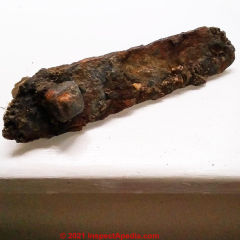
@Eleanor,
In the article in a higher place you we should be sure to read the section on the direction of atomic number 26 fibers as a interruption point in aging Nails
Clinched Nails could non be aptitude over without breaking until iron fibers were made to run parallel to the length of the nail.
I am interested in the age of these 'carve up nails'. Information technology is an erstwhile oak door and at attaching the bolt on the other side of the door.
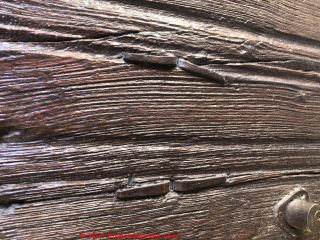 .
.
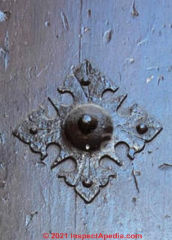 Thank you lot for the photo.
Thank you lot for the photo.
Very dainty; looks like brass or copper; am I correct?
A bulbous headed tack / nail of matchstick size might accept been used where its head was left exposed to view, such as a decorative nail in a door or other building feature; smaller gauge tacks with decorative heads also evidence up on upholstered furniture.
Any information near the history of the specific site in the Hague might requite u.s.a. more clues.
To go WAY back you might relish seeing
Butler, J.J., BRONZE Historic period METAL and Bister in kingdom of the netherlands [PDF] Academy of Groningen Library, Netherlands, retrieved 2021/08/30 original source: https://ugp.carpet.nl/Palaeohistoria/article/download/24902/22350
@Andrew Wills, here's an excerpt from a photograph of a wooden door with metallic decorations that might include bronze seedling-headed short nails.
In improver to all the information about old nails on this page, I encourage you to meet the information and examples at the following articles:
Antique Blast Age & History FAQs Q&A on Nails as Indicators of ...
inspectapedia.com/interiors/Age-of-Nails-FAQs.php
and
Age and History of Antique Nails
https://inspectapedia.com/interiors/Make up one's mind-age-of-former-nails.php
Hi - I found the nail shown in the attached image in a friend'south garden in The Hague in the The Netherlands. Whatever information nigh its history would be much appreciated.
Many cheers
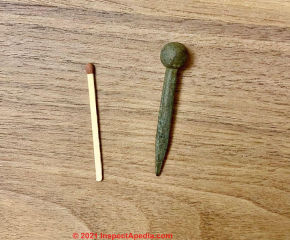
@Leslie Weyhrich,
Bear witness u.s. a photo of raisin head nails and tell u.s. what you tin about the product - that may help locate the box you want.
looking for an original box of raisin caput nails don't need the nails only the box!
@J Norris,
In improver to all the data virtually old nails higher up on this page, you may savour learning more at the post-obit manufactures:
AGE AND HISTORY OF Antique NAILS
https://inspectapedia.com/interiors/Decide-age-of-old-nails.php
ANTIQUE NAIL AGE AND HISTORY FAQs
inspectapedia.com/interiors/Age-of-Nails-FAQs.php
I am curious about this nail, which was given to me. Give thanks y'all. It is five inches long.
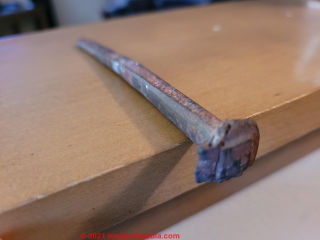
@Beck,
Thank you for the interesting photos and for your question. We can't come across enough nor practise nosotros have any other contextual information to say more than there appear to be a couple iron fragments. With respect to historic period, there are some clues in the article above. Also see:
Age and History of Antique Nails
https://inspectapedia.com/interiors/Decide-age-of-old-nails.php
I found these recently on two separate embankment walks. They look handmade but I'yard non sure what I take here. Any ideas?

@Whitney Tomlin,
In addition to all the information about old nails on this page, accept a expect at the following page and its like shooting fish in a barrel questions to assistance make up one's mind blast historic period:
Historic period and History of Antique Nails
https://inspectapedia.com/interiors/Determine-age-of-old-nails.php
Y'all may also enjoy examples from other readers' 'finds' at:
Antique Nail Age & History FAQs
inspectapedia.com/interiors/Age-of-Nails-FAQs.php
Hi! Wondering if you all might exist able to help me determine the age of an old farmhouse I'm currently working on. I have managed to pull one of the original nails out without damaging the boom as well much. Delight have a look at the prototype and let me know if you have any idea. Thanks!
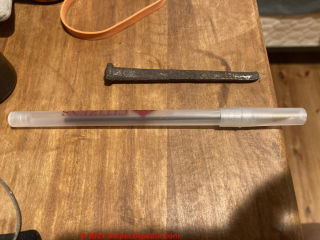
@Anonymous,
Sure, in the article above accept a look at the description of cut nails.
We are doing a roof to a house that got finished in 1905 the rumor is the house started being built in 1901 there has been only 2 people to own the place...we found a few of these nails information technology looks like the same mode nails in the moving-picture show that says they are vintage tin someone aid me to meet what kinda nails these are?
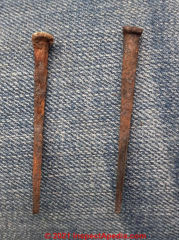
@Keith,
That is certainly a remarkable Spike. I don't know what information technology was for. Possibly Timber framing.
Sometimes people cut grooves in the spikes to amend their resistance to withdrawal just more-likely their regularity suggests that those are grip marks left by machinery used in nail or spike production.
I institute this metal detecting on an old rural Nova Scotia belongings. Whatsoever idea how quondam it is? What are the grooves for? Measures 3/4" square and about 5 3/4" long
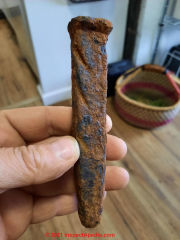
@RoboElv,
The uniformity and course of those tacks and the fact that a black blanket remains on them all expect "modern" to me.
Keep in listen that tack-making machines are amidst the oldest of machine-made nails and fasteners.
@inspectapedia.com.moderator, Thanks I did wonder that although they seem quite chunky and solid. Given the pyramid head on them someone did advise they were "old style decorative Atomic number 26 door, gate wood studs craft nails". I fabricated a mistake on the showtime message to, they are 30mm top to bottom.

@RoboElv,
Mayhap upholstery tacks, those are large-head machine-made tacks. Probably modernistic.
I don't know if they are old or not although we have had a material sack of nails in the back of various garages for at least 50 years, The heads are effectually 2cm across and the nail 2cm long. The heads are round although take a cross outcome on them with the heart beingness raised.
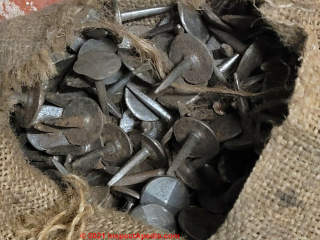
@Susan Row,
That looks similar a modernistic cutting-boom, and those diagonal indents may be artifacts of the boom-making machine's gripping machinery.
In addition to all the information about former nails on this folio, I would suggest the following commodity which will give you several easy questions to help determine the age of this blast. Especially as information technology was part of your grandmother'due south estate, yous may have relevant knowledge as to its age as you look at these questions:
Age and History of Antique Nails
https://inspectapedia.com/interiors/Decide-age-of-erstwhile-nails.php
And in that location are examples from other readers' 'finds' at:
Antique Nail Age & History FAQs
inspectapedia.com/interiors/Historic period-of-Nails-FAQs.php
Please allow us know if you have additional questions.
Recently I had a forest frame repaired. Information technology came from my grandmother'due south estate. The human who did the repairs gave me one of the tiny nails that he had to remove, because he thought it interesting and very sometime. It has 4 sides and is distinctly rectangular. How accurately can its age be determined? It is 1 inch long.
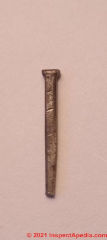
@Bill,
That nail is quite rusted only it looks as if the shaft and caput were paw-forged; have a look nether magnification to see if there are whatsoever splits that bespeak direction of iron fibres. Then see:
Smash Age DETERMINATION KEY - use this central to judge at the age of your nail or spike
Contains our best suggestions for maiming surrounding contextual data and making physical observations that volition assist you judge at the age of a boom or Spike
Hi, I institute this smash near the site of the old Boonton Iron Works / New Jersey Iron Company site (operational late 1700's to 1911. It'due south ii.5" long and the head is 0.5" across.
Tin can you delight aid me empathise a scrap more well-nigh it? specially interested in knowing how former it is. Thanks, Bill
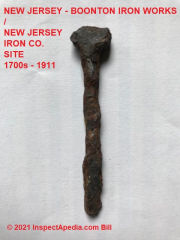
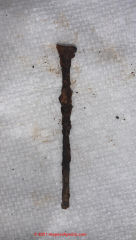 @Due east,
@Due east,
In addition to all the information about one-time nails on this page, you may enjoy learning some new facts and examples at the following articles:
ane) AGE AND HISTORY OF ANTIQUE NAILS
And in that location are examples from other readers' 'finds' at:
2) NAILS & HARDWARE, AGE FAQs Q&A on Nails as Indicators of Building Age
Hello! I recently found this boom while out metal detecting. Do you possibly know how old information technology is? Give thanks you so much!
@Hollywood Hills trail,
How-do-you-do!
I found this I retesting nail upwardly in the Hollywood Hills in Bronson County beneath the Hollywood Sign (not under it, but at the base of the trail).
Any idea of how old information technology might be?
Dave
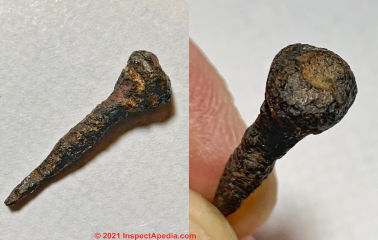
@inspectapedia.com.moderator,
The nails go into the paper... simply that doesn't mean that the paper wasn't old when the nails when into information technology.
The only other visible hardware on the frame are some eye-bolts belongings the wire/cablevision to hang the (heavy) frame. The cablevision looks old-but 'modernistic.'..like to electrical wires that used to be insulated on the outside from maybe the 1920's ish).
I tin can say that I was trying to accept photos of all iv sides of the nails that I had wiggled out-- I noted that the smaller has a pocket-sized twist in it.. similar it didn't quite lay flat every bit I turned it onto 2 of it's sides.
I might just take to look until I come across a need to actually reframe. Information technology'south pretty dainty the manner it is.

@Denise,
Are you confident that those nails are original - and thus similar in historic period as the paper?
Are there other types of nails in the same frame?
Those nails look quite directly - if they're cut they may exist more than mod than we first guessed. Are at that place any burr marks for cuts on the nail edges?
This is a nice example of using contextual evidence (newsprint) to help engagement an object like an old nail.
These nails are holding on the back console of the frame holding a lithograph I recently bought at a 2nd hand store.
While not necessarily of the aforementioned timeline, the lithographer is from Berlin, the benefactor, New York. I but purchased information technology in Oregon.
The edges of the newspaper (that I tin can see) beneath the framing have American spellings, and there is a reference to Ellis H. Roberts (a politiician of the 1870's) - I've non removed the whole panel to get a date from the newspaper as I don't want to mess with the framing only to satisfy my curiosity.
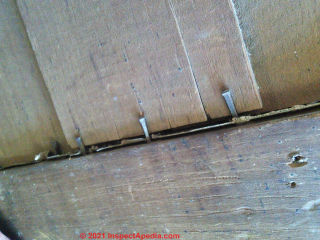
@J d byers,
Dainty. What else practice we know: country, city, location of find, nail dimensions, backdrop, appearance, historic period of buildings nearby? Photos?
We found a blast that has J on the head
@Joshua,
Looks equally f it may be but it's so badly corroded it's lost a lot of the original cloth and so its clues.
Across looking just at that spike or nail, encounter the historic period-guessing assistance at NAIL AGE Conclusion Primal
https://inspectapedia.com/interiors/Determine-age-of-sometime-nails.php
Is this nail hand forged?
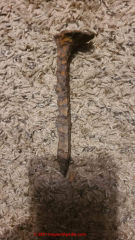
...
Continue reading at Blast AGE DETERMINATION KEY questions & answers, or select a topic from the closely-related articles beneath, or see the complete Commodity INDEX.
Or see NAILS & HARDWARE, AGE FAQs - questions & answers posted originally at this page and additional photos of sometime and newer nails
Or come across these
Nail & Hardware Age Conclusion Articles
- Historic period of a Edifice, HOW to DETERMINE - domicile
- DOOR HARDWARE Age
- NAILS & HARDWARE, AGE - domicile
- NAILS & HARDWARE, Historic period Inquiry
- NAIL AGE DETERMINATION KEY - use this primal to guess at the historic period of your nail or spike
- NAILS Manus-WROUGHT & REPRODUCTIONS
- Smash & HARDWARE Make clean-UP
- RAILROAD SPIKES
- SAW & AXE CUTS, TOOL MARKS, Historic period
- WINDOW HARDWARE AGE
Suggested citation for this web page
NAILS & HARDWARE, Historic period at InspectApedia.com - online encyclopedia of edifice & ecology inspection, testing, diagnosis, repair, & trouble prevention communication.
Or encounter this
Alphabetize to RELATED Manufactures: Article Index to BUILDING AGE
Or use the SEARCH BOX establish beneath to Ask a Question or Search InspectApedia
...
Enquire a Question or Search InspectApedia
Attempt the search box just below, or if you prefer, mail service a question or annotate in the Comments box below and we volition answer promptly.
Search the InspectApedia website
Notation: appearance of your Annotate below may be delayed: if your comment contains an image, web link, or text that looks to the software as if it might exist a web link, your posting volition appear later it has been approved by a moderator. Apologies for the delay.
Technical Reviewers & References
Click to Show or Hide Citations & References
Publisher InspectApedia.com - Daniel Friedman
Source: https://inspectapedia.com/interiors/Nails_Hardware_Age.php
Posted by: kovachcubled.blogspot.com

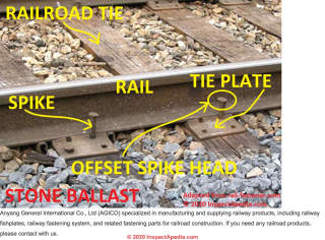
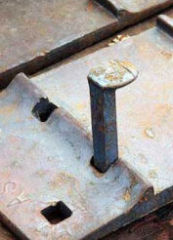

0 Response to "What Were The American Waltham Nail Tin Boxes Used For"
Post a Comment